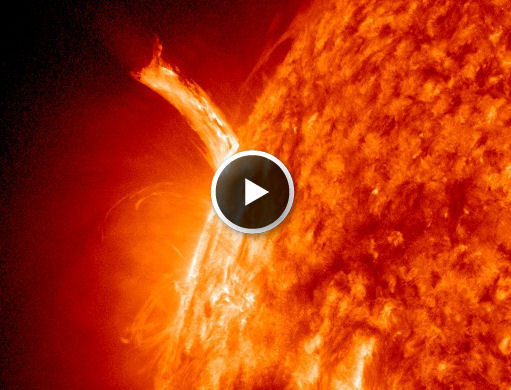Turn your cell phone into a field-tested satellite tracker. Works for Android and iPhone. | | |
DARK FIREWORKS ON THE SUN: NASA has just released new movies of an inky-dark solar explosion that continues to puzzle experts more than a month after it happened. See the footage from Science@NASA.
WEAK IMPACT: A coronal mass ejection hit Earth's magnetic field around 0852 UT on July 11th, but the impact did not provoke strong geomagnetic activity. Nevertheless, high-latitude sky watchers should remain alert for auroras as a fast stream of solar wind blows around our planet.
EASTERN UNREST: An active region emerging over the sun's eastern limb is hurling material high above the stellar surface. NASA's Solar Dynamics Observatory recorded some of the action during the early hours of July 12th:

This eastern unrest is not Earth directed. Forecasters say the greater threat for geoeffective activity comes from sunspot 1247 (finder); it has a "beta-gamma" magnetic field that harbors energy for M-class solar flares. There is a 10% chance of such eruptions during the next 24 hours.
ELECTRIC BLUE MORNING: On Sunday morning, July 10th, a bank of noctilucent clouds (NLCs) swept across Europe. Instead of the usual rosy-red, the sunrise over Poland was electric blue:

"This morning I witnessed a spectacular display of NLCs--the best I've ever seen," reports photographer Marek Nikodem of Szubin, Poland. "The clouds were more than 180 degrees wide and 100 degrees high. It was a fantastic show."
July 2011 has been a banner month for these mysterious clouds. Normally confined to polar latitudes, NLCs have been sighted in recent nights as far south as France in Europe and Kansas and Colorado in the United States. Sky watchers at all latitudes are encouraged to be alert for electric blue; observing tips may be found in the 2011 NLC photo gallery.
2011 Noctilucent Cloud Gallery
[previous years: 2003, 2004, 2005, 2006, 2007, 2008, 2009]
June 2011 Aurora Gallery
[Aurora alerts: text, voice] [previous Junes: 2010, 2008, 2001]
June 15th Lunar Eclipse Gallery
Potentially Hazardous Asteroids (
PHAs) are space rocks larger than approximately 100m that can come closer to Earth than 0.05 AU. None of the known PHAs is on a collision course with our planet, although astronomers are finding
new ones all the time.
On July 12, 2011 there were 1237 potentially hazardous asteroids.
Notes: LD means "Lunar Distance." 1 LD = 384,401 km, the distance between Earth and the Moon. 1 LD also equals 0.00256 AU. MAG is the visual magnitude of the asteroid on the date of closest approach. | | The official U.S. government space weather bureau |
| | The first place to look for information about sundogs, pillars, rainbows and related phenomena. |
| | Researchers call it a "Hubble for the sun." SDO is the most advanced solar observatory ever. |
| | 3D views of the sun from NASA's Solar and Terrestrial Relations Observatory |
| | Realtime and archival images of the Sun from SOHO. |
| | from the NOAA Space Environment Center |
| | the underlying science of space weather |
| | for out-of-this-world printing and graphics |

